Beefing Up the Graphics Capabilities of the Pi 3
tl;dr: The ODROID-C2 is a very solid competitor to the Raspberry Pi model 3 B, and is anywhere from 2-10x faster than the Pi 3, depending on the functioning. The software and customs back up is nowhere near what you get with the Raspberry Pi, merely it'south the best I've seen of all the Raspberry Pi clones I've tried.
The original Raspberry Pi was the showtime mass-marketplace 'single board' reckoner that kicked off a small calculating revolution in terms of hardware interaction via GPIO, experimental monitoring, automation, and robotics projects, etc. Through the past few years, it has evolved from being a very slow and express computing platform to being as fast as some lower-specced smartphones, and can now run a desktop Linux environment bearably well. The Raspberry Pi 2 and Pi 3 (just announced on February 29—run across my review of the Pi 3 here) were the start models with quad core processors, and they're both decent generic Linux computers, particularly for the low $35 price tag!
Once the Pi became a popular production, similar single board computers were introduced with different features and functionality, in a similar price range. I recently reviewed i of the main competitors, the Orange Pi Plus, which for $39 offers faster networking, onboard fast eMMC storage, and a bevy of other features—but which also requires a lot more than try to get up and running, and has nowhere nigh the community and documentation surrounding the Raspberry Pi.
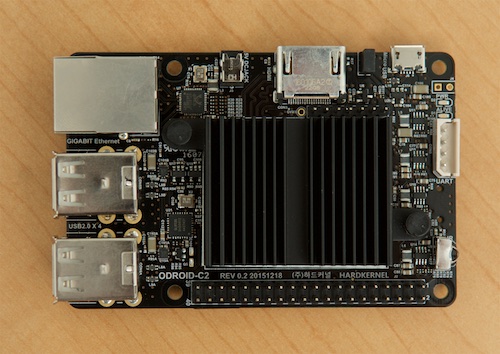
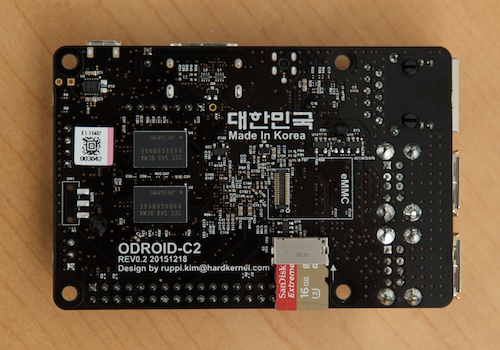
Another primary competitor in the infinite is the ODROID, from Hardkernel. The original ODROID-C1 was already a decent platform, with a few more features and more RAM than the comparable Pi at the time. The ODROID-C2 was just appear in Feb, and for $39 (only $5 over the Pi 3 price tag) offers a few great features over the Pi 3 like:
- 2GHz quad core Cortex A53 processor (Pi 3 is clocked at 1.two GHz)
- Mali-450 GPU (Pi iii has a VideoCore IV 3D GPU)
- 2 GB RAM (Pi 3 has i GB)
- Gigabit Ethernet (Pi 3 has ten/100)
- 4K video support (Pi iii supports Hard disk... drivers/support are commonly ameliorate for Pi though)
- eMMC slot (Pi 3 doesn't offering this pick)
- UHS-ane clocked microSD carte du jour slot (Pi 3 requires overclock to get this speed)
- Official images for Ubuntu xvi.04 MATE and Android (Pi 3 uses Raspbian, a Debian fork)
The Pi 3 added built-in Bluetooth and WiFi, which, depending on your utilise case, might make the toll of the Pi 3 even more appealing solely based on a feature comparison.
But features and specs are really simply the tip of the iceberg. As I found when reviewing the Orange Pi, there are many factors you have to consider when evaluating what single board computer makes the near sense for your projects or usage; especially if you're not a hardcore Linux kernel hacker, yous might want to consider factors similar the user customs, forums, and software support you become from the companies/foundations behind the boards.
Acquiring an ODROID-C2
Different the Pi iii (and pretty much every Pi since the B+), there'south no huge run on ODROID-C2s, so I went to the official Us benefactor's site (AmeriDroid) and bought an ODROID-C2 for $41.95 plus $seven shipping (I also added in an official clear example and the recommended power adapter, for convenience—though you can power the ODROID-C2 through the USB OTG port but similar the Pi). Note that at that place was a contempo post in the ODROID forums stating that the outset batch of ODROID-C2s had already been sold out as of March 16, simply many distributors withal have them in stock.
Getting a Pi iii can be an exercise in frustration; near a month in, information technology's just in stock in some stores, and people are nevertheless price gouging past selling at higher prices with cheaply-assembled Pi starter kits and on eBay. I was lucky to discover them in stock at my local Micro Center for list price; the state of affairs should improve over time... only considering the Pi Nada is still perpetually out of stock everywhere, the Pi Foundation definitely needs to beef upwardly its manufacturing and distribution partnerships to run into demand!
Hardware
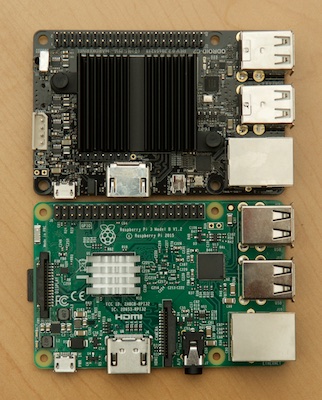
A view of the ODROID-C2 and Pi 3 from the elevation.
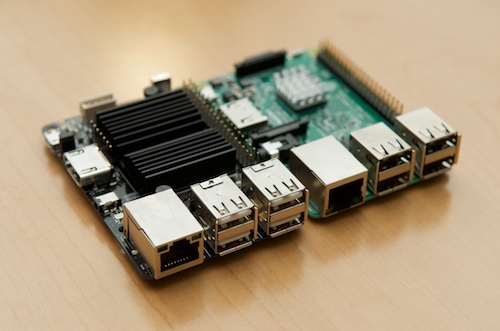
A view of the ODROID-C2 and Pi 3 from the side.
One of the first major differences between the Pi 2/three and the C2 is the massive heat sink that's included with the ODROID-C2. Based on my observations with CPU temperatures on the Pi three, the heat sink is a necessity to keep the processor cool at its fairly loftier 2 GHz clock. The board itself feels solid, and it feels like it was designed, assembled, and soldered slightly meliorate than the larger Orange Pi Plus, on par with the Pi 3.
1 extremely thoughtful feature is the ODROID-C2 board layout mimics the Pi B+/2/iii virtually exactly; the largest components (east.g. LAN, USB, HDMI, OTG, GPIO, and even the screw holes for mounting!) are identically placed—meaning I can swap in an ODROID-C2 in most situations where I already have the proper mounts/cases for a Pi.
Setup and first boot
The procedure for setting upward an ODROID-C2 is pretty much the same every bit the Raspberry Pi; you download the official Os paradigm from the advisable wiki folio (in this case, I downloaded Ubuntu xvi.04 1.1), aggrandize the image file (since it's a big .xz file, I used The Unarchiver for Mac to expand it), then flash it to a microSD bill of fare.
On my Mac, I inserted a Samsung EVO 16GB card, ran diskutil unmountDisk /dev/disk2, so ran sudo dd if=image-expanded.img of=/dev/rdisk2 bs=1m to re-create the image to the microSD card. The official Ubuntu image is over five GB, so it takes a little time. (For the Pi, there'due south an official CLI-only 'Raspbian Low-cal', which clocks in effectually 1 GB, so it's footling faster to re-create.)
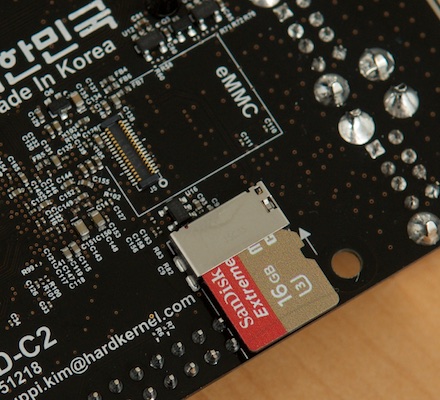
The microSD card slot is in a peculiar location, just clearing the GPIO pins on the underside.
Insert the microSD carte du jour into the slot on the underside of the ODROID-C2 (information technology's in a bit of a strange location, with the card sticking out over the soldered GPIO pin connections), then plug in your keyboard, mouse, and HDMI monitor, and then plug in power to boot it upward.
Information technology boots to a pleasing Ubuntu desktop login folio (default admin username is odroid with the countersign odroid), and after commencement kicking, everything is configured and set up to get. One nice thing virtually the setup experience is you don't have to manually run sudo raspi-config and expand the filesystem manually (or do the aforementioned via a GUI config panel)—on showtime boot, the OS expands the filesystem to encompass your whole microSD card automatically.
The official Ubuntu MATE surroundings is nice, just for ameliorate efficiency, I used the ODROBIAN Debian Jessie ARM64 image for ODROID-C2 instead. The download is only 89 MB compressed, and the expanded epitome is ~500 MB, making for an almost-instantaneous
ddoperation. There are some other images available via the customs as well, only ODROIBIAN seems to be the near reliable—plus it already has excellent documentation!
Using the C2
Since it defaults to Ubuntu MATE, the desktop environment is pleasant (more then than Raspbian's default GUI), and it even comes with both Chromium and FireFox installed, so you tin can choose from one of the two most pop and well-supported browsers. However, later on I ran sudo apt-get update && sudo apt-get upgrade (which took quite a while the starting time time) to make sure all packages were upwards to date), neither Chromium nor FireFox would launch; they would launch and then quit afterward a few seconds. And so I re-imaged the card (which took a couple hours) and tried over again.
Chromium took about 4 minutes to launch the starting time time (it seemed like nothing was happening, but one CPU core was spiked at 100% the whole time), and FireFox took about eight seconds the first fourth dimension. Afterward that, both took 4-5 seconds to launch, and cipher seemed dull or inconsistent when using them.
Most apps that come preinstalled with MATE worked flawlessly, though every once in a while FireFox or Chromium would crash and need to be restarted (Chromium much more so than FireFox—see this forum topic). Hopefully this is just a growing hurting with a relatively new ODROID revision and a new Bone distribution, simply it's a little disconcerting, especially after hearing grief on some forums about Hardkernel being stuck on the Linux iii.x kernel for a while.
It'south hard to friction match the level of software/Os back up the Raspberry Pi foundation and customs provides, but of all the single board computers, the ODROID-C2 and the Hardkernel community seem to have the most solid basis; reading through forum posts like Ubuntu 16.04 LTS for ODROID-C2 makes me confident that the Hardkernel devs and community are working to polish out the crude patches, and in but the past calendar month, the progress has been first-class!
Benchmarking the C2 vs Pi iii vs Orange Pi Plus
For the Pi Dramble, I have a few hurting points with the current generation of Raspberry Pis; I could always use more raw CPU speed (that's the main bottleneck for authenticated web requests), merely one of the even more important considerations is network bandwidth—the Pi iii's limited coach only allows upwards to ~95 Mbps over wired lan, or up to ~321 Mbps if using a USB 3.0 adapter. The ODROID-C2'southward faster CPU clock, default UHS-1-clocked microSD reader, and built-in Gigabit Ethernet port paint a corking portrait on newspaper—merely the proof is in the pudding. Every bit with all my other reviews, I've run the ODROID-C2 through my benchmarking gauntlet to compare it to the Pi 3 and Orange Pi Plus.
CPU Benchmarks
Others have already beaten the CPU benchmarks to expiry; architecturally, the quad-core Cortex A53 64-bit processor is very shut to the Pi 3's processor; however, the .8 Ghz faster clock charge per unit and larger memory allocation does provide a marked increase in functioning over the Pi 2/iii for many tests, including some real-world Drupal spider web awarding tests later in this mail.
Network
A fast and reliable network link is important if you either need lots of throughput for things like serving lots of spider web traffic or passing effectually files on a network (eastward.g. using the ODROID-C2 equally a NAS). I accept comprehensive networking benchmarks posted on the Pi Dramble site for the Pi 2 and Pi 3, but let'due south meet how the ODROID-C2 compares:
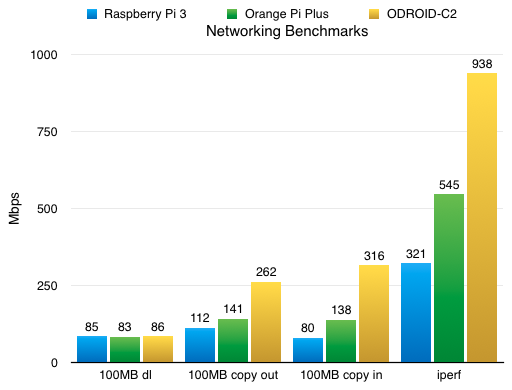
The raw stats:
- 100 MB file download (via 100 Mbps Net, onboard Gigabit Ethernet): 10.seven MB/south (10.6 MB/due south on Pi 3)
- 100 MB LAN file copy from ODROID-C2 to Mac (onboard Gigabit Ethernet): 32.7 MB/s (thirteen.98 MB/s on Pi iii)
- 100 MB LAN file copy from Mac to ODROID-C2 (onboard Gigabit Ethernet): 39.five MB/s (9.98 MB/southward on Pi 3)
-
iperfraw throughput (onboard Gigabit Ethernet): 938 Mbps (321 Mbps on Pi iii)
iperf gave admittedly an absolutely rock solid 938 Mbps, which is awesome—the Orangish Pi was a piffling shaky in its results, varying in test runs from 300-750 Mbps, but never getting virtually a full ane Gbps throughput. The Raspberry Pi 3 can get 95 Mbps on the built in 10/100 Ethernet port, or upward to 321 Mbps on a Gigabit USB 3.0 adapter. The ODROID-C2 delivers on the networking throughput in spades; pair information technology up with a nice SSD in a USB enclosure and a fast eMMC bill of fare, and this could exist an splendid option for NAS or any kind of streaming!
Power consumption
For some projects (and in full general, in my opinion), the amount of power that's drawn is an important consideration. Typically, the less current draw the better, especially if you don't have as skillful a quality power supply, or might need to run the lath off a battery for certain applications (e.m. mobile robotics, mobile sensors, mesh networks). I have a proficient overview of power consumption for the various Raspberry Pis, and hither are a few stats for the ODROID-C2:
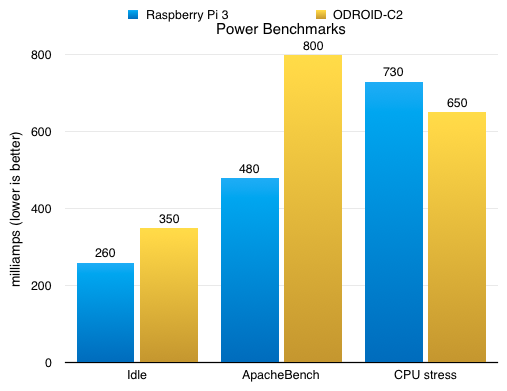
The raw stats:
- Idle, no keyboard: 350 mA (260 mA on Pi three)
- ApacheBench webserver stress test: 800 mA (480 mA on Pi 3)
- 400% CPU load: 650 mA (730 mA on Pi 3)
The nearly surprising thing to me is how the ab stress test (basically hitting Drupal difficult for a long fourth dimension, pegging the CPU cores, the memory, and the microSD bill of fare at the same time with uncached requests) used a lot more than power on the ODROID-C2 vs the Pi three. The Pi 3 must take a fiddling better power optimization overall, while the ODROID-C2 has a niggling better power optimization for the CPU itself.
Storage / microSD card
Unfortunately, I am not able to examination the eMMC performance at this time as I don't have the required module, just I did run a set up of benchmarks confronting the congenital-in microSD card reader (using a Samsung EVO 16 GB card), comparing the results to a Raspberry Pi 3 running Raspbian (with the microSD card reader overclocked):
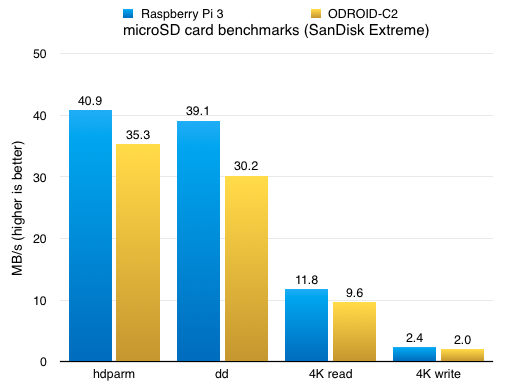
The raw stats:
-
hdparmbuffered: 35.29 MB/southward (40.88 MB/s on RPi) -
ddwrite: thirty.2 MB/s (39.1 MB/s on RPi) -
iozone4K random read: ix.64 MB/s (11.77 MB/south on RPi) -
iozone4K random write: two.04 MB/s (2.36 MB/s on RPi)
I posted more than comprehensive benchmarks for microSD cards on the Raspberry Pi, merely what I think may be even more than interesting is running the Bone off the eMMC; it promises to be five-10x faster than even the fastest microSD cards I've tested, and it'south not too expensive an improver to the ODROID-C2 (the 8GB eMMC module with Ubuntu is currently $21).
Without microSD card overclocking turned on for the Pi, the numbers for the Pi are all basically halved—be wary of any benchmarks that claim the Pi 2/iii are 2x slower than the ODROID-C2 or other boards... the only existent difference in that instance is the Pi defaults to a more stable slower clock for the microSD reader, but if y'all have adept microSD cards (UHS-1 or better), in that location's non much run a risk to overclocking the reader.
Drupal functioning
For my purposes, one of the most comprehensive benchmarks is 1 that tests the full LEMP stack, pegging all 4 CPU cores, hitting disk I/O heavily, and consuming most of the onboard RAM. I used the Drupal Pi projection to quickly install the LEMP stack on the ODROID-C2, with Nginx one.6.ten, PHP 7.0.ten, and MySQL 5.six.x. It installs a copy of Drupal viii.0.5, which can exist a pretty heavyweight application if y'all featherbed all of Drupal'due south caching. Here are the results:
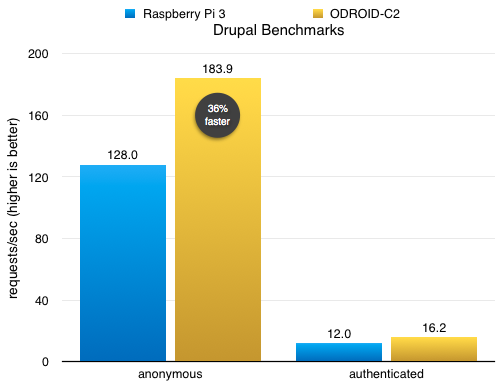
The raw stats:
- Anonymous (cached) requests (Drupal 8.0.5, PHP 7): 183.93 req/southward (128.03 req/s on Pi)
- Authenticated (uncached) requests (Drupal viii.0.five, PHP seven): xvi.18 req/s (12.02 req/south on Pi)
- Cached requests (Nginx equally reverse proxy): 9,860 req/s (ii,220 req/s on Pi)
The ODROID-C2 is almost 40% faster than the Pi three across the board... meaning I'm a little scrap tempted to switch a couple of the Pis in my existing Pi Dramble out with ODROID-C2s, but for the squeamish speed heave! Here are the total Drupal benchmarks on a Pi 2 and Pi iii for comparison.
Annotation that, when measuring fully cached results—where the network bandwidth is the limiting factor—the ODROID-C2 blows the Pi out of the h2o, fifty-fifty if the Pi uses a Gigabit USB three.0 adapter, due to the incredible speed reward the onboard 1 Gbps Ethernet provides.
Summary and recommendations
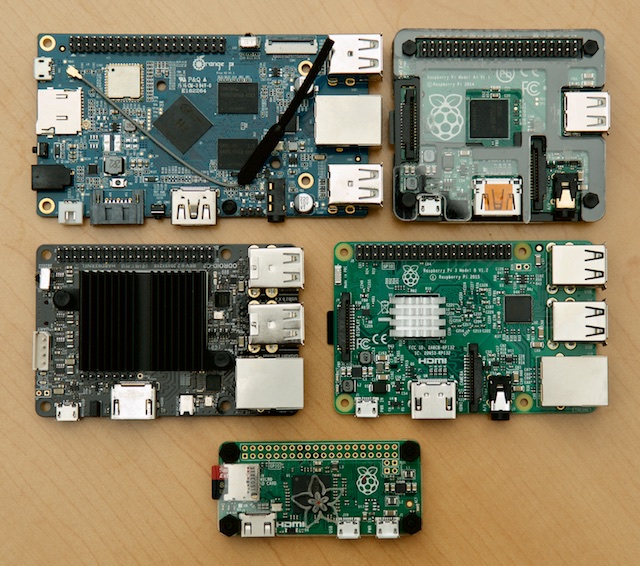
A few years into the small-scale unmarried-board ARM reckoner revolution, the playing field is starting to level out; the Raspberry Pi is perpetually the leader in terms of breadth of customs and mindshare, while various clone manufacturers try to differentiate based on slightly differing feature sets and spec bumps. Some clones' documentation and community are painfully inadequate, leading to a bad initial feel and frustration with any small problems.
The ODROID-C2 is a very solid competitor to the Raspberry Pi model 3 B, and is anywhere from 2-10x faster than the Pi three, depending on the operation. Information technology'south network performance, CPU performance, and 2 GB of RAM are extremely strong selling points if you thirst for better throughput and smoother UIs when using it for desktop computing. The Mali GPU cores are fast plenty to do about anything you tin do on the Raspberry Pi, and the (smaller, but dedicated) community surrounding the ODROID-C2 is quick to help if y'all run into issues.
The ability to easily install Android or Ubuntu MATE (or one of the community distros, like ODROBIAN) is a benefit, and instructions are readily bachelor (more and so than other clones).
One of the all-time advantages of the C2? Y'all can likely catch one within a few days, shipped via one of Hardkernel'due south distributors. Practiced luck getting a Pi iii at list price in the side by side few weeks!
The fact that I'm considering adding an ODROID-C2 to my Raspberry Pi Dramble cluster should indicate how highly I regard information technology as an alternative to the Raspberry Pi 3 for use as a headless server. For unmarried-board beginners, and for general stability and ongoing back up, you'll take more success and happiness starting with a Pi 2 or Pi iii. But for those used to the ecosystem and the limitations of ARM-based Linux, the ODROID-C2 is a very nice production!
Yous can buy the ODROID-C2 from ameriDroid for $41.95.
Source: https://www.jeffgeerling.com/blog/2016/review-odroid-c2-compared-raspberry-pi-3-and-orange-pi-plus
0 Response to "Beefing Up the Graphics Capabilities of the Pi 3"
Post a Comment